
Good fortune to you, dear reader, I am most glad to see your path has led you here to McGee’s. On this fine day, I would like to delve into the endless mysteries of the Knights Templar with you. We will take a glimpse at the Templar goings-on around the world, and then, as per tradition, we shall dive deeper into what may (or may not) have been taking place when they roamed the lands of Bohemia.
First and foremost, allow me to clue you into the origins of the Templar Order. Their full title stands as the Poor Fellow-Soldiers of Christ and of the Temple of Solomon, but you likely know them by a different name – the Knights Templar.
In the dusty chronicles of history, the Knights Templar are something of an enigma. The Order was founded in 1119, in the aftermath of the First Crusade – a first in the series of military campaigns orchestrated by the Pope and the European Christian powers to retake the Holy Land and Jerusalem from the Muslims. This feat of faith took place between 1096 and 1099, and out of the harsh realities of pilgrimage rose the Knights Templar. At first, only nine devout knights, led by Hugues de Payens, a young man from the French town of Troyes, sought to protect Christian pilgrims traversing the perilous roads of the Holy Land. They took vows of poverty, chastity, and obedience, and bound themselves entirely to their mission.
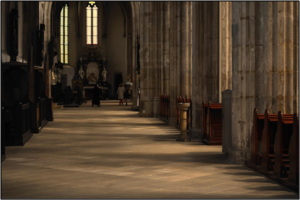
In that same year of 1119, Hugues de Payens approached King Balduin II of Jerusalem with the proposal of creating an official monastic order out of himself and his companions. The King granted his request and gave the Order quarters in the sacred precincts of Temple Mount – a hill in the Old City of Jerusalem seen as one of the holiest sites there is in Christianity, Judaism, and Islam alike. As part of this, they also gained the official title I mentioned to you earlier – ’’Poor Fellow-Soldiers of Christ and of the Temple of Solomon’’, the Temple of Solomon being a biblical temple in Jerusalem likely between the 10th and 6th centuries BC, believed to have stood on Temple Mount prior to its destruction by Babylonian King Nebuchadnezzar II.
For about a decade to come, these knights operated from a place of great poverty and overall minimal resources, and for the most part remained as the original nine founding members. Apart from the Frenchman Hugues de Payens, who eventually became the first ever Grand-Master of the Templars, there was also Godfrey of Saint-Omer – a Flemish knight, or André de Montbard, another Frenchman who would go on to become the fifth Grand-Master of the Templars. A vital change for the state of the Order eventually arrived in the form of powerful advocacy from Bernard of Clairvaux, today known as Saint Bernard (canonized in 1174). He was the nephew of André de Montbard and a prominent Church figure, and circa 1129 he wrote an official work – Libre ad milites templi de laude novae militiae (’’Book of the Knights of the Temple, in praise of the new knighthood’’), in favour of the Templars.
’’A Templar Knight is truly a fearless knight, and secure on every side, for his soul is protected by the armour of faith, just as his body is protected by the armour of steel. He is thus doubly armed, and need fear neither demons nor men.’’
(Libre ad milites templi de laude novae militiae, Bernard of Clairvaux, circa 1120-1136)
He presented it at the 1129 Council of Troyes and led a number of prominent churchmen to officially approve and endorse the Knights Templar on behalf of the Church. What followed was a quick and large gain of esteem, as well as land, business and new recruits from the ranks of noble-born sons of families eagerly awaiting an opportunity to aid in the fight for the Holy Land. In 1135, the Templars even received the first monetary donation from the Pope, and four years later in 1139 Pope Innocent II passed the bull Omne Datum Optimum, which exempted the Templars from adherence to local laws.
As you might imagine, dear reader, this final move of support truly anchored the Templars into a strong position; it meant they could effectively pass through all borders freely, didn’t have to pay taxes, and evaded all official authority except that of the Pope himself. Like this, the Order rather swiftly became a force to be reckoned with; be it militarily, as well as in terms of influence, and resource – from money to weaponry to clandestine information.
Avoid the crowds at Prague Castle with a mystery tour of alchemy and astrology, taking you to magical locations like New World, Strahov Monastery or Prague Loreto.
3 hour tour | from 26 €
Explore hidden places in Old Town and fill your evening with ghost stories and legends full of death, poverty, misery, or murder.
1,5 hour tour | from 16 €
Discover the history of psychiatry and learn about the development of Prague’s famous psychiatric hospital on its vast grounds.
3 hour tour | from 26 €
This state of affairs however did not remain for long. Past the mid-12th century, the tide of the Crusades began to turn in favour of the Islamic forces. At the same time, the Knights Templar, aiding the losing Christians, were clashing with the other two Christian military orders – the Knights Hospitaller (The Order of Knights of the Hospital of Saint John of Jerusalem) and the Teutonic Knights (The Order of Brothers of the German House of Saint Mary in Jerusalem). At last, in 1187, Jerusalem was recaptured by Muslims and would, with a decade-long exception in 1229 (the Sixth Crusade), remain in their hands until 1917. After this crucial change in hands, the Templars understandably could not tarry in their Temple Mount headquarters any longer and relocated to other lands further North. In the following decades, the Crusaders lost their foothold in the Holy Land completely, and this, dear reader, posed a rather fundamental question for the Templars. What now?
They were no longer able or needed to protect and fight with the pilgrims and crusaders journeying to the Holy Land, hence, support for their mission diminished quickly and considerably. That however would not and could not suddenly erase the way in which the Templars had rooted themselves into the foundations of Christendom. They traded locally, ran businesses, locals would use the Templar Order as a bank of sorts, storing with them personal valuables, as well as being employed at the various Templar-run establishments. All the while, the Templars were still free from all official authority but that of the Pope, despite the fact that they were no longer serving a common mission, and they could still traverse borders as they pleased. As you can imagine, dear reader, European nobility was more than a little discontent with this status quo, and soon endeavored to change it.
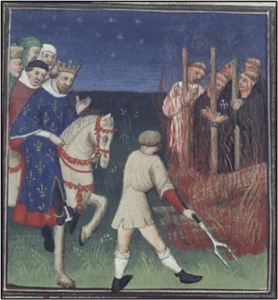 What unfolded was, whether rightly or not, a decidedly harsh suppression of the Order, culminating in its official dissolution. I’m afraid I will need to spare you the details, dear reader, not for a lack of interest or willingness, but simply because it would take far too long to examine the full extent of what happened. In essence, however, the cascade of events began in 1305, with Pope Clement V contacting the Knights Templar and Knights Hospitaller Grand-Masters Jacques de Molay and Fulk de Villaret (respectively) to Avignon. One of the discussed matters was criminal charges that much of the European nobility – discontent as they were, had filed against the Templars in the preceding two years. The charges accused the Templar Order of corruption in their ranks, and of manipulating the legal dealings in Europe for their benefit. The Pope and Jacques de Molay agreed in the end that the charges were likely false, however, to be sure, the Pope sent a written request to King Philip IV of France to aid him in the investigation. That, dear reader, is where matters would take a very, very poor turn for the Templars. You see, King Philip was greatly indebted to the Order for their aid in his war against England, and desiring to avoid paying off the debt which he could not afford, Philip began to press the Church to persecute the Templars.
What unfolded was, whether rightly or not, a decidedly harsh suppression of the Order, culminating in its official dissolution. I’m afraid I will need to spare you the details, dear reader, not for a lack of interest or willingness, but simply because it would take far too long to examine the full extent of what happened. In essence, however, the cascade of events began in 1305, with Pope Clement V contacting the Knights Templar and Knights Hospitaller Grand-Masters Jacques de Molay and Fulk de Villaret (respectively) to Avignon. One of the discussed matters was criminal charges that much of the European nobility – discontent as they were, had filed against the Templars in the preceding two years. The charges accused the Templar Order of corruption in their ranks, and of manipulating the legal dealings in Europe for their benefit. The Pope and Jacques de Molay agreed in the end that the charges were likely false, however, to be sure, the Pope sent a written request to King Philip IV of France to aid him in the investigation. That, dear reader, is where matters would take a very, very poor turn for the Templars. You see, King Philip was greatly indebted to the Order for their aid in his war against England, and desiring to avoid paying off the debt which he could not afford, Philip began to press the Church to persecute the Templars.
In 1307, on 13th October – a Friday, mind you, he ordered a mass arrest of hundreds of Templars, including Grand-Master de Molay himself, with the official edict beginning:
“Dieu n’est pas content, nous avons des ennemis de la foi dans le Royaume”,
meaning “God is not pleased. We have enemies of the faith in the kingdom.”
King Philip IV made other criminal allegations against the Templars, all the way from denying Christ and spitting on the Cross, to homosexual practices and various acts of ‘devilry’ and worship akin to that of witches and pagans, a prospect that did not go down well with the Christian establishment, as I’m sure you can imagine. To add severity to the claims, other accusations such as fraud, corruption and dealing as well as keeping of clandestine information were thrown into the mix. Soon torture, interrogations and trials of the Templars were taking place. Some had sufficient legal material to defend against the claims, and when forced to admit to them under torture would immediately recant those confessions upon release, however, King Philip would disrupt any attempt the Templars would make to vindicate the Order, and in 1310 had scores of Templars burned at the stake in Paris.
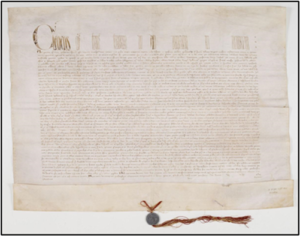
After that, he gave Pope Clement, who likely hadn’t originally wanted to so severely tear down the Order, an ultimatum – either he disbands the Templars completely, or the King will take military action against him. And with that, dear reader, effectively came the end of the Knights Templar. Pope Clement’s priority was to consolidate power for the Church, and so in 1312, at the Council of Vienna, he proclaimed a series of bulls such as Vox in excelso, dissolving the Order, and Ad providam, transferring Templar assets to the Knights Hospitaller, one of the other two prominent Christian military orders I mentioned to you previously. And as if that was not enough in 1314, Grand Master Jacques de Molay – the last Templar Grand Master who held the position through all this downfall, and the Templar Preceptor of Normandy – Geoffroi de Charney, were burned alive at the stake based on allegations of heresy. Interestingly, this event is one of the significant sources of supernatural lore surrounding the Templars, so let us now investigate the more mysterious side of things.
When the last Grand Master, Jacques de Molay, was burned at the stake in 1314, it is said he cursed King Philip IV of France and Pope Clement V, proclaiming that they would both soon join him in death. Remarkably, both men died within the year. According to the legend, as the flames consumed him, Jacques de Molay these words:
“God knows who is wrong and has sinned. Soon a calamity will occur to those who have condemned us to death. God will avenge our death. I summon you, Philip, and you too, Clement, to the tribunal of God within the year!”
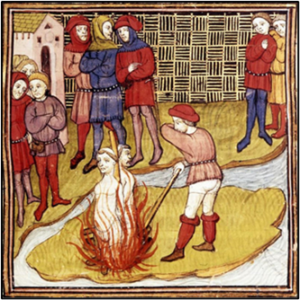
Pope Clement V died just over a month after de Molay’s execution, on 20th April, 1314. His death came after an illness, which some accounts describe as agonizing, interpreted by many as divine retribution for his role in the Templars’ persecution.
King Philip IV died later that same year on 29th November 1314, in a hunting accident. He suffered a stroke and fell from his horse, an event that many saw as the fulfillment of de Molay’s curse.
Another legend that surrounds the Templars is the tale of the Holy Grail – the chalice used by Jesus at the Last Supper. There are stories, dear reader, and they are not few in number, that suggest that during their time in the Holy Land, the Templars found this fabled artifact and brought it back to Europe.
If you recall the Templar origins in the 12th century, King Balduin II of Jerusalem gave the Order the ancient site of Temple Mount as headquarters. There, they conducted extensive excavations, believing it to be the location of the now-ruined biblical Temple of Solomon, and we in fact know that they did end up uncovering ancient texts and relics throughout this process. There are those who claim that among them was the Holy Grail.
The findings of the Templars would have been transported back to Europe, and kept secret from all, including the Church. Why, you may ask? They are Holy Christian relics after all, and the Templars were officially obliged to answer to the Pope. You see, the Holy Grail supposedly possesses many magical abilities; powers beyond imagining, and the Templars would have likely sought to keep it safe from anyone who may abuse its powers, even the Pope himself.

As for the hiding place of the Holy Grail, remaining well past the dissolution of the Templar Order, some suggest that it was hidden in Rosslyn Chapel in Scotland, a site with intricate carvings and Templar symbolism, built by the Sinclair family, who were said to have Templar connections. The other most popular theory places it inside the Valencia Cathedral in Spain. The cathedral houses a chalice known as the Santo Cáliz, which has been venerated as the true Grail since the medieval period. It was even recognised by Pope John Paul II in the 20th century as a possible candidate.
Another enduring myth is that during the Temple Mount excavations, the Templars also found the Ark of the Covenant, a sacred chest that held the tablets of the Ten Commandments and was given to Moses on Mount Sinai by God. The Ark, according to the Book of Exodus, is made of acacia wood, overlaid with pure gold inside and out, and adorned with gold. The lid, known as the Mercy Seat, depicts two cherubim with outstretched wings. Much like with the Holy Grail, the Templars would have likely transported this biblical artifact to a safehouse in Europe, in order to protect and harness its supernatural properties.
You see, dear reader, the Ark, according to mythology, is a sort of divine guide and instrument of God’s power. For instance, in the Book of Joshua it is linked to the parting of the Jordan River, allowing the Israelites to cross on dry land. Then, during the Battle of Jericho, the Ark was carried around the city walls for seven days, after which the walls miraculously collapsed. The Book of Samuel also describes the Ark bringing plagues upon the Philistines when they captured it, forcing them to return it to the Israelites, and several historical accounts describe individuals being struck dead for touching or looking inside the Ark without authorization.
One needn’t wonder for very long to understand why it would be so sought after by all manners of peoples over human history, or why the Templars may have hidden it – that is if they ever found it in the first place. It is anyone’s best guess where, however, and some may argue that is for the better if it is as powerful as legends say.
During the trials leading to their downfall, the Templars were accused of idol worship and in particular of worshipping an idol called Baphomet. The exact nature of this idol remains an enigma, with theories ranging from it being a demon, to a misinterpretation of Islamic symbols. The name ’’Baphomet’’ only appears for the first time during the Templar trials, when several knights confessed under torture to worshipping an idol named Baphomet, described variously as a severed head, a statue, or a mysterious figure. These confessions were likely coerced and as we’ve talked about often recanted after release from prison, thus the nature of Baphomet remained very vague.
That is until 1854, with the release of a book titled Dogme et Rituel de la Haute Magie – ’’Dogma and Rituals of High Magic’’, written by a French poet and mystic Éliphas Lévi. In his book, Lévi drew Baphomet in the traditional imagery that still defines it today – the features of a goat and a human, permeated by various symbols of duality; light and dark, male and female, good and evil. It was later adopted by the renowned occultist Aleister Crowley and his religious philosophy of Thelema, and by Anton LaVey, the founder of the Church of Satan. Nevertheless, no such idol has ever been found, and there is no concrete archaeological evidence for it. Thus, the enigma of Baphomet remains to be uncovered, including any and all occult knowledge it may contain, and supernatural powers it may hold.
I could talk on for ages about the various Templar mysteries, dear reader, for there are many. For example, the Templar Seal – a distinctive seal depicting two knights on a single horse, found on Templar documents and artefacts and also somewhat shrouded in mystique. Or the Templar Cipher Stones – stones with strange inscriptions and symbols discovered in various locations across Europe, promising the possibility of some secret messages or hidden knowledge passed down by the Templars. Or of course, the infamous Chinon Parchment, discovered in the Vatican Secret Archives in 2001, revealing that Pope Clement V in fact secretly absolved the Templars of heresy in 2008 – one of the reasons why so many of them, particularly outside of France where King Philip IV mercilessly persecuted them, escaped and reintegrated into different orders, forms of service and ways of life. And we have hardly even touched on the endless tales of hidden Templar treasure. Alas, I must resort to only these little hints, which you can later research on your own. After all, we have yet to discuss the promised stories of the Knights Templar in Bohemian lands.
The Knights Templar seemed to have arrived in the Kingdom of Bohemia (part of the Holy Roman Empire) around the year 1232, at least according to the Chronicle of Hájek and several other sources of the time, such as a French letter from 1241 naming a particular Templar master in charge of the Order’s operations in Bohemia. This is also when some of the primary Templar commanderies (fortified monasteries) were established – one in the village of Čejkovice, another by the Church of St. Vavřinec in Prague, and a third one in the form of Castle Templštejn, built by the Templars. Throughout their time here, the Order particularly enjoyed the patronage of Wenceslaus I, called One-Eyed, who was King of Bohemia from 1230 to 1253. His support helped them establish a strong foothold in the region, and they acquired extensive properties including villages, churches, and lands. Be that as it may, following King Philip’s 1305 accusations and arrest orders, and despite the reluctance of the then-Bohemian King Wenceslaus II to carry them out, the Templars ended up disappearing from Bohemia in the official capacity, much like they did in the rest of the World. Behind them however, they left a whole realm of mysteries…
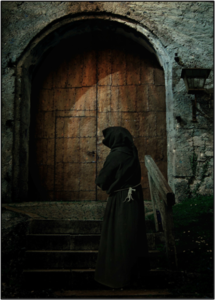
The most notable Bohemian Templar is a man by the name of Ekko, a Templar Commander. We do not even know whether ‘Ekko’ was his true name, but it certainly was the title he was addressed by in the letters thanks to which we know of him in the first place. The first mention of him is in a written document from 1292 as the Commander of the Čejkovice headquarters, and then in 1302 as the provincial Templar Commander for the Czech, Moravian and Austrian lands. We know Ekko was very close with King Wenceslaus II, likely serving as an advisor of sorts. Unfortunately, dear reader, that is about where our knowledge ends. Ekko was a very enigmatic man, it is not even really known what he would or could have been advising the King on, it is not as though Wenceslaus did not have official royal advisors, and so one can let one’s imagination run wild. There are still some official documents detailing his activities in the Royal Court in 1310, when the Templar Grand-Master de Molay was already imprisoned, and other Templars burned at the stake in France, but following the 1312 Vox in excelso papal bull dissolving the Order, Ekko disappears from all records.
Blatná Castle lies 95 kilometers south of Prague, and according to legend, it was founded by the Knights Templar around the year 1235, when the Castle was first mentioned in a written document. Supposedly, the Templars hid a vast treasure within its walls when they left. They marked the location with secret symbols and inscriptions as was their tradition, and the key to the treasure is said to be depicted in a painting on the wall of one of the chambers.
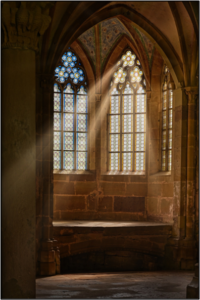 Many sought after it in vain until the castle scribe deciphered the mysterious codes. He tapped the wall behind the painting and discovered it was hollow. He entered the secret alcove and in it found a treasure of some kind. Neither the scribe nor the treasure were ever seen again, only a hole in the wall remained, and in the cavity behind it, just a few coins. The painting was then painted over, so the precise entry point has been lost to time as well.
Many sought after it in vain until the castle scribe deciphered the mysterious codes. He tapped the wall behind the painting and discovered it was hollow. He entered the secret alcove and in it found a treasure of some kind. Neither the scribe nor the treasure were ever seen again, only a hole in the wall remained, and in the cavity behind it, just a few coins. The painting was then painted over, so the precise entry point has been lost to time as well.
Dačice is a town on the border of South Bohemia and Moravia. There stands the Old Castle Dačice, bearing the coat of arms of Albrecht Krajíř of Krajku. Legend has it that the palace was once inhabited by the Templars, and that a stone hand pointing to a hidden treasure was walled up in the cellar.
During the Thirty Years’ War (1618-1648), a detachment of Swedes arrived in Dačice and stayed for several days. One captain was housed in the castle, thereby protecting the house from looting and ravaging by unruly soldiers. The captain always treated the household members with care and kindness. For this, all the household members respected and loved him as if he belonged to their family.
On the evening before his departure, the captain was joking with the steward’s children as usual, when one of the children in jest threatened him with tales of the stone hand in the cellar. Alerted by the threat, the captain asked the child’s father about the stone hand, and was told that it was built over with brick by the Templars long ago because it pointed to their hidden treasure. The captain asked whether the treasure would be his if he found it.
“With all my heart, I gladly give it to you,” the housemaster replied and added: “My ancestor dug deep into the wall and found nothing; you will find even less – there is no talk of a bricked-up treasure here, rather it is said to be cursed.”
Then the captain went to the cellar, examined the underground rooms and called several soldiers to help dig into the wall where the hand apparently used to be. Soon, the wall was broken through, revealing an alcove where a tin coffin lay. In it, they found the remains of a human body along with valuable items.
A significant number of ancient, completely unknown ducats were found, which the captain distributed partly to the soldiers, and partly to the steward’s children. They also found a large chain with a cross, which he gave to the steward’s wife. For himself he kept three large books with rare paintings, a silver armour with a helmet, and a precious sword, before deprecating from Castle Dačice, never to be heard from again.
Not far from Mikulov, in the Pavlov Hills, the Klentnice Castle was built into the rock. One day, a Templar Knight by the peculiar name of Čičoš showed up and took up the role of keeper of the Castle. He was a strong and capable knight, and helped for many years to defend the Klentnice lands against the Tatar attacks. It was a dangerous time, and many feared for their lives. During one of the Tatar invasions, a young lady from the country hid near the Castle and upon running into the Knight, asked him for help. He offered her protection, encouraging her to stay at the Castle till danger passed. Čičos knew that the Čejkovice Knight Commander would never condone this, as it was against the Templar vow of chastity, however he thought the risk was worth saving the lady ́s life.

After some time, she rarely left the Castle, despite him often asking whether she would not like to. The times were no longer so terribly dangerous, and he did not want her to waste her life away. Alas, as they would speak around the dinner table, she told him that unless he did not wish for her company any longer, she would like to stay. He chuckled, saying that of course, he did not wish to kick her out, but that they could not remain living together any longer without being married, it was not appropriate. The young lady was quite happy to marry the Knight, and soon became pregnant. Čičos was growing more nervous every day, afraid his Commander would discover his transgression and punish not only himself, but his family and people of the Castle and surrounding land. However, he did not want to scare his wife, and so he never told her the full story of his origin and of the Templar vows.
One day, riders on horseback appeared not far from the Castle and galloped straight up the steep path. The Castle guards reported to Čičoš that the Templar Commander from Čejkovice was heading towards them. They met the Knight and his wife and newborn son in the Castle’s courtyard and immediately surrounded them with swords drawn. The wife clutched their son, not even yet named or baptized, to her chest, while her husband stepped up to his Commander. The Commander said to him that he had heard rumors of the transgression that took place at Klentnice Castle and wanted to see for himself if they were true, and now seeing they were, would immediately bestow a severe punishment onto Čičoš and his family. They tried to plead with the Commander to forgive them and baptize their son himself.
He agreed, ordering his party to set up a baptism in the courtyard, before performing the rites. He spoke aloud, giving the little baby the name of Orfanus. The wife began to breathe a sigh of relief, while her husband cried aloud in horror. “Orfanus…orphan!”. Not understanding her husband´s distress the woman could only stare as the Commander seized her husband´s sword and broke it in half, ending his Templar vow, and then cutting off his head. Right after, he ordered his men to do the same to her and all the Castle workers, before leaving the Castle behind with little Orfanus, who would grow up in the Templar Order, only to return home and discover his tragic heritage after serving them for most of his life dutifully, through pain and danger.
One late afternoon, a carriage with a pair of young, Dominican monks and their driver was travelling the road towards Brno. They were headed back from a journey across the country, collecting money wherever they could to build a Church in their city of Brno. The people in the last village they passed had warned them to stay the night as it was getting dark and they could easily get lost, however wishing to be back home as soon as possible, the monks pressed on.

As you may have guessed, dear reader, they of course got lost, and just as they were beginning to panic, they saw a light in the distance. Following it, they discovered a castle with servants and a Castle lord, who offered them a plentiful meal and comfortable beds for the night. When they told him of their mission, he also endowed them with a small chest and a few loose ducats, saying it was his contribution to their Church project back in Brno, and that his only request was that they only open the chest once they arrived home, not a glimpse before then. As the monks travelled the road away from the castle, the ducats in their pockets suddenly turned to dust, and the castle behind them disappeared. Perplexed, they grumbled about the entire experience with disappointment, and recounted it to their supervisor – the prior, upon arrival in Brno, expecting the chest to be full of dust as well. Remarkably however, as soon as the supervisor opened it, they found it full of gold, gems and adorned chalices.
The whole strange affair weighed heavily on the prior’s mind, grateful as he was, and he searched through the old books in the archive of Brno. There, he read that at the site near Jamolice, the village the two monks passed before getting lost and stumbling on the mysterious castle, that once stood Castle Templštejn, which was eventually burned and demolished by conflict. Once every hundred years, however, it is said that the Castle appears for one night as it was during its greatest glory. The prior figured that it was precisely on that miraculous night that the young monks arrived at the castle. And what happened to the treasure you may ask, dear reader? The monastery council indeed decided to use it to build two beautiful tall towers on the Dominican church. They have survived to this day.
Alright, dear reader, I believe that will be it for today. As is the tradition with these articles of mine, I do feel compelled to mention that in no way did I manage to truly even scratch the surface of the vast enigma that is the Knights Templar. For one, that would be entirely too long for one article, not to mention we quite frankly just do not know a lot of the information surrounding the Order. Much of it has either been permanently lost to time or not yet discovered. Still, I am as always glad to have shared this investigation with you, be it about the Templar goings on around the world, or here in Bohemia. I do hope you might feel inclined to keep researching the topic yourself, I promise there is much more to learn and it certainly does not lack excitement. For now though, I will wish you good fortune and hope to accompany you in the next one.
Neli Kozak